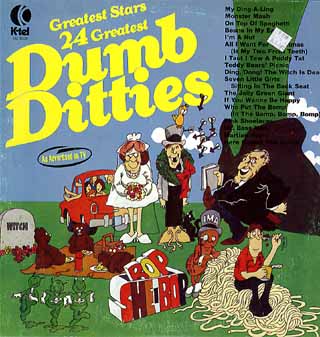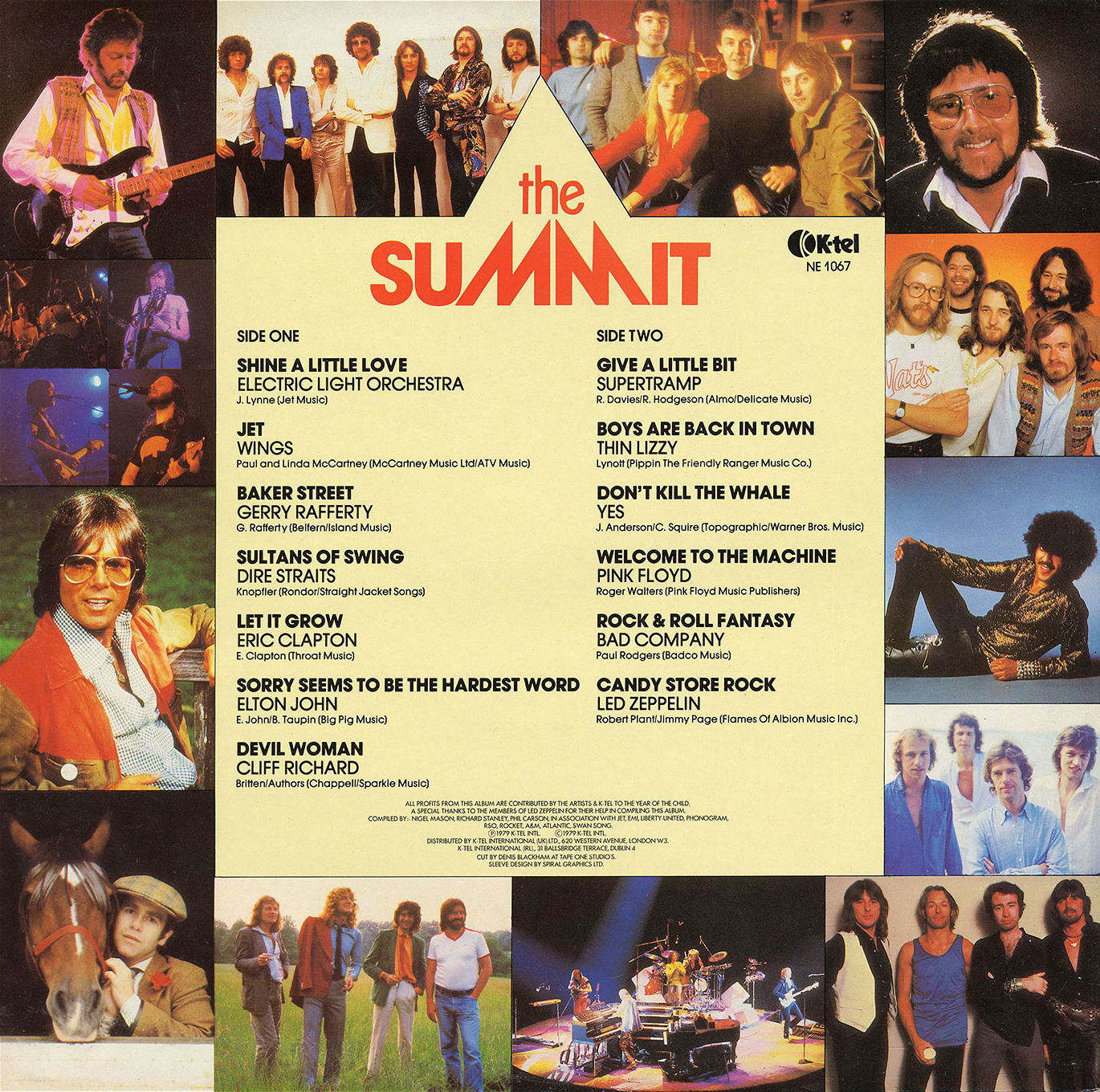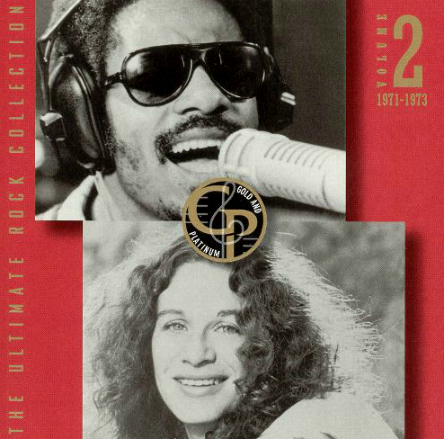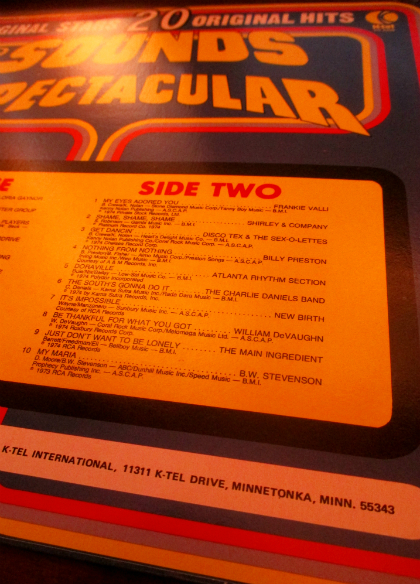True or False? Led Zeppelin have appeared on a K-Tel album.
Answer:
⇓
⇓
⇓
⇓
⇓
⇓
⇓
⇓
⇓
⇓
True!
The band that famously refused to do TV appearances did not, generally speaking stoop to K-Tel‘s level of crass commercialism. Led Zeppelin cultivated such a mystique amongst their fanbase, in fact, that it was thought the band didn’t deign to do singles — obviously untrue when you browse their 7-inch output on 45Cat (each and every Zep album was accompanied by a 45 release, don’t kid yourself).
And yet, unbelievably, Led Zeppelin once said yes to K-Tel: 1980’s The Summit, released by K-Tel UK & Ireland — an album that includes “Candy Store Rock” (from 1976’s Presence), fittingly as the final track:
“Candy Store Rock”
Led Zeppelin (1976)
Does the band get forgiveness points, since “proceeds from this album are contributed to The Year of the Child to help sick and handicapped children”?
As Herc’s K-Tel Albums explains —
“Hot on the heels of the Kampuchea concerts, K-Tel rush-released The Summit in January 1980, featuring a baker’s dozen of tracks from rock royalty, all of whom donated their proceeds to UNESCO’s The International Year Of The Child (1979). Kurt Waldheim, then secretary-general of the United Nations, was crucial in organizing both the Concerts for the People of Kampuchea and The International Year Of The Child projects.”
Zep on K-Tel cover!
click on image for maximum resolution
Nevertheless, we can’t let Zeppelin fully off the hook, given their powerlessness in preventing “Whole Lotta Love” — the 3-minute edited version, no less — from being used on a ‘Warner Special Product’ (namely, 1973 box set Superstars of the 70’s), thus giving their high-falutin reputation a slight blemish. Note, too, the existence of an ‘alternate‘ Superstars of the Stars 4-album collection that includes “D’yer Maker” (instead of “Whole Lotta Love”), as well as Hendrix track “Freedom” (versus “Purple Haze” and “Foxey Lady”).
‘Alternative’ Superstars of the 70s 4-LP collection
“D’yer Maker” and Hendrix’s “Freedom” would reunite for another Warner Special Product — 1974’s Heavy Metal 2-record set, with “24 electrifying performances” (see Marketing Case Studies below for more info).
Could easily pass for a K-Tel cover, right?
“Whole Lotta Love” would get trotted out again for 1976 Warner Special Product LP, Listen to the Music.
3 songs one could not escape in the 1970s:
1997 would prove historic, as Zeppelin permitted “Misty Mountain Hop” (of all things) to be the band’s special contribution to Time-Life’s Gold and Platinum, Vol. 2: 1971-1973, in collaboration with Warner Special Products.
In 2003, Jimmy Page would even make the CD cover, when “Misty Mountain Hop” made an encore appearance on Time-Life’s Do It Again from the ‘Legends’ series (with liner notes from Ben Fong-Torres), also in synergistic partnership with Warner Special Products.
*
Marketing Case Studies:
Heavy Metal – A Warner Special Product
July 1975 issue of Circus
*
Minnetonka, Minnesota:
The New “Hitsville USA“?
Thanks to family members strategically located in Minnetonka, Zero to 180 is grateful to have had the opportunity to visit 11311 K-Tel Drive, the corporate headquarters of K-Tel International since 1975, as any music scholar will tell you.
11311 K-Tel Drive:
Leafier than 2648 W Grand Blvd
(via 1975’s Sounds Spectacular)
K-Tel’s former address in Mid-City:
421 Wilson Street, NE
(via 1974’s Today’s Super Greats)
K-Tel’s service in maintaining the commercial vitality of our great nation’s pop hits – long after their initial “expiration date” – has been widely mocked, which is sadly short-sighted, given the company’s honorable efforts in fighting Madison Avenue attitudes (i.e., old = bad) that have unmistakably infiltrated popular consciousness due to a relentless bombardment of advertising that fetishizes newness for the sake of newness.
K-Tel would celebrate 35 years of success in grand style with a supplemental 17-page advertisement in the March 8, 1997 edition of Billboard.(pages K-1 through K-17) that includes messages of congratulations from Sony Music Special Products, EMI-Capitol, Polygram, Curb Records, Select-O-Hits, local heroes The Trashmen, The Castaways, Steppenwolf’s John Kay, the Marshall Tucker Band, and Ernest Evans himself (a.k.a., Chubby Checker). These 17 packed pages include a profile of founder Phillip Kives (K-Tel = Kives Television), who “starred in what may have been the first infomercial: a five-minute spot in support of a non-stick frying pan,” plus a history of the music label (“Original Hits! Original Stars! K-Tel’s Super Gold Music Machine Rolls Right On”) that states the company’s musical inventory to be “approximately 2,700 masters, dating from the ’50s up through the ’80s and beyond.”
K-Tel
Your Green Light to Hits
But mere months later, Don Jeffrey would report on a worrisome organizational restructuring of K-Tel International in Billboard‘s November 22, 1997 edition —
Just months after terminating a deal that would have divested its music assets, K-Tel International has restructured the music company and set ambitious plans to become an online music retailer and a distributor of other labels’ recordings.
As part of the change, the company has tapped Mark Dixon, its top financial executive, as COO of the music unit, K–Tel International (USA), which remains based in Minneapolis. The corporate offices, however, are moving to Los Angeles, where company president David Weiner will oversee the music unit, international operations, a direct-marketing subsidiary, a home video imprint, and a new Internet venture. Weiner says the move will enable K-Tel to “tap into a larger talent pool.”
By mid-December, Weiner says the company will launch K-Tel Online and develop the site over the next year into a major Internet retailer to compete with CDnow, Music Boulevard, and World Wide Web sites operated by traditional music chains. At the site www.ktel.com, consumers will also be able to order customized CDs made up of tracks from the company-owned catalogs.
Alas, Greg Beets would break the sad news — “Where were you when you found out K-Tel declared bankruptcy and shut down its U.S. music distribution subsidiary?” — in the May 4, 2001 edition of the Austin Chronicle. Turning popular wisdom on its head, Beets points out that “although K-Tel’s buffet-style MO [modus operandi] seems quintessentially American,” the company was actually founded in Winnipeg, Ontario in 1962, before Kives moved operations to Minneapolis in the early Seventies.
Kives wasn’t the first (that would be Art Laboe‘s Oldies but Goodies series), and he wasn’t without competition (Ronco and Adam VIII), but “it was K-Tel,” Beets observed, “that truly cultivated the form into a pop culture institution ripe for parody.”
*
K-Tel’s Krass Kommercialism –
A Tribute by Greg Beets
Originally published in the May 4, 2001 edition of The Austin Chronicle
During the Seventies, K-Tel’s marketing ploys had the same seedy appeal as a carnival barker’s come-on. The pitch was fast and furious, with deftly spliced snippets of music, song titles rapidly scrolling across the screen, and an overcaffeinated announcer imploring you to order now. Some aficionados swear the ads said K-Tel albums were not available in stores, even though they were — at unhip outlets such as drug and discount stores.
You won’t find a much better snapshot of pop music in the early Seventies than 1972’s Believe in Music. Named for Gallery’s “I Believe in Music,” the album kicks off with the 1-2-3 feel-good punch of “Brandy (You’re a Fine Girl)” by Looking Glass, “Beautiful Sunday” by Daniel Boone, and “Sunny Days” by Lighthouse. Throw in Donny Osmond, the O’Jays, and a few more weird obscurities like Mouth & MacNeil’s “How Do You Do?” and Bulldog’s “No,” and you have a bass-ackwardly definitive compilation rivaled only by Nuggets.
Maybe K-Tel butchered art for profit. But even if that were true, does it make K-Tel any worse than a record company padding a marginal artist’s album with filler? Though it came at the expense of artistic vision, K-Tel’s Seventies output was nothing if not value-driven. Where else could you get up to 25 hit songs for the low, low price of $5.98 ($7.98 for 8-track)?
That said, the sonic quality of vintage K-tel albums is truly awful. You’ll find better low end on a distant AM radio station, and the flimsier-than-Dynaflex vinyl ensures quick scratches if you so much as breathe too hard on it. And no discussion of K-Tel would be complete without mentioning the blinding colors and screaming fonts utilized in the subtle-as-a-meat-cleaver cover art. But, as the tired old saying goes, that’s part of the charm.
Note: Beets would also voice the widely-held notion that “respectable artists, such as the Beatles and the Rolling Stones, never showed up on K-Tel” — a view that, as Zero to 180’s recent research has revealed, does not withstand factual scrutiny.

*
*
Minnetonka in Music History
100 years or so ago, Minnetonka had served as the inspiration for Thurlow Lieurance‘s oft-covered [Paul Whiteman, Glenn Miller, Three Suns, Bud Isaacs, Billy Mure] composition, “By the Waters of the Minnetonka,” from 1914 (PDF of original sheet music courtesy of Greer Music Library — Digital Commons @ Connecticut College).
Marty Gold Orchestra & Chorus (1959)















